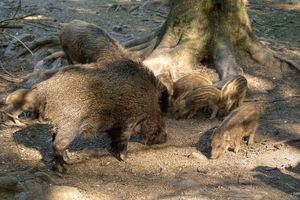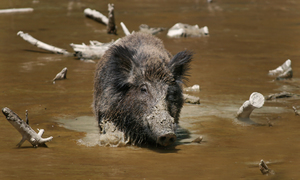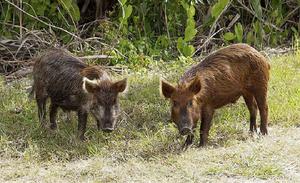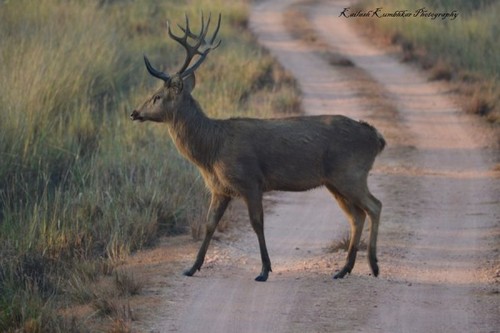Wild boar is a hoofed mammal of the family “pigs”. Also known as “boar” or “wild pig”. Animal is a distant relative of the domestic pig. The boar is actually a pretty smart creature.

And brave defending their territory and family, desperately thrown into the battle. The victim, a wild beast cracked down easily and quickly strong fangs struts entire body length. For humans wild boar can also be very dangerous.
The appearance and weight of the boar
Unlike the domestic pig boar has a short and strong body. The height of a wild boar rarely reaches one meter. The length comes down to about two. On average, the wild boar usually weighs more than 250 kg. But sometimes there are much larger and heavier individuals.
For example, American hunter once killed a wild boar with a body length of three meters. Fangs of the wild pigs was equal to 70 cm and a weight of 300 kg. In Russia a novice hunter once shot an animal, the body weight of which was about 550 kg. later it turned out that this big wild pig has increased due to mutation. In China once there lived a boar weighing about 900 kg. After the death of the beast, he made a Scarecrow and placed in the Museum. And in the UK the farmer has grown the large boar. At about four, a length of almost three meters, it weighs more than six tons.
Leg of wild boar is longer than in domestic pigs, and noticeably thicker and more muscular. Thanks to this, the boar runs quite quickly, which often saves it from the claws of the predator. Also can swim and is smart. Vision in wild pigs is bad, but there is a great sense of smell and excellent hearing, which helps the boar hunt. Sharp fangs males reach 20 cm.
The size and shape of head of wild boar is also different from domestic pig ears slightly longer form pointed, they are erect. The fangs are more sharp and strong than the pigs. In males they are more developed, larger in size and out of the mouth.
The hair on the back forms a mane that stands on end when the animal angrily. In winter, the fur of the pig is growing more active and becomes more dense. Hair color – dark brown and a present brick color. Can be small spots of dark gray. All together creates the overall color in brown-dark tone. In General, the color depends on the specific location of the habitat of the animal. The boar can sometimes have very light hair, but such colors are rare .
Piglets up to 1.5 years painted-another – color is a few stripes of different colors, so the baby merged with the surrounding background, and thus was difficult to see for predators.
The animal has a tail, the length of which varies from 10 to 40 cm.
The area
Range of accommodation the wild boar is quite wide:
- Europe;
- India;
- The Middle East;
- East and South-East Asia;
- Asia Minor;
- The Northern regions of Africa;
- Some places in Siberia, in the South of Irkutsk oblast, Krasnoyarsk Krai, in some woods in the suburbs;
- The Eastern part of America;
- In some places in Australia.

Wild boar prefer to live in wooded areas. In search of food, often comes at the meadow highlands with a maximum height of 3300 m. in Some places actively populated and foliage of the forest.
The U.S. wild boar was specially imported for hunting purposes. In Australia, wild boars are actually feral domestic pigs. They lead the same lifestyle, and wild pigs from Europe and referring to a separate boars do not consider them.
In many places the wild boar was destroyed. In England almost all wild boars killed in the 13th century, Denmark 19. In Russia the number of wild boars has drastically declined for 30 years. In the 50’s people began work on the restoration of the wild boar population. Now they are found even in such places as, for example, Losiny Ostrov near Moscow.
Types
There are several types of wild boars and many subspecies.

Some of them:
- Boar. Lives in some woods of Europe and Asia. Was introduced in the United States. There are about 20 subspecies.
- Big forest pig. Habitat – forests in Africa. Weighs about 200 kg. it was opened not so long ago, at the beginning of the 20th century. Eats only plant food.
- River Cisterna pig. Lives in Central Africa. The coat color is reddish, and on the back is an oblong strip of white. Food uses almost everything. Eating plants and meat of small animals, and insects, and even carrion.
- Bearded pig. South-East Asia. This is one of the most lean types of pigs. Weight rarely exceeds 50 lbs. and Eats almost everything.
- Warthog. Lives in Africa. The name he was given because of the growths that cover the torso, and the head of the animal. The dimensions are quite large: height of about one meter, and weight around 150 kg.
- Babirussa. Habitat – an island part of Indonesia. The weight of the animal about 80 kg, height at the withers almost a meter. This kind malopolovets, the female gives birth to two piglets. Is the list of most rare species.
Lifestyle, habits and nutrition
The most beneficial conditions for living are wooded or swampy area. The boar loves to take mud baths – so cleans wool from parasites.
Males often live alone, but to join the herd only when the time comes for mating. The herd consists of 15-30 females, young and weak, young males. Head herd female.
Wild boar is fast, but somewhat clumsy. Is able well to float and travel considerable distances. The nature of a wild pig is not cowardly, but rather cautious. But if something happens, for example, defending cubs, fiercely rushed at the enemy. The boar, being in a state of irritation or simply wounded, it is also very dangerous. Large strong fangs inflict terrible wounds. In addition, the animal is quite fast. And when you consider the considerable body size and large mass, a wild boar may be the enemy of a very dangerous enemy.
In the daytime the animal digs a hole and resting. And in the evening out of the den in search of food.
The diet of the wild boar is quite extensive:
- Plant foods, roots, tubers, leaves, young grass, nuts, fallen fruit, shoots;
- Worms, insects, frogs, birds and eggs from nests, which can reach;
- Do not hesitate to eat carrion;
- Harmful, devastating the fields, digging potatoes, cereals, turnips eating;
- Sometimes attack injured or sick large animals, such as deer.
Lifespan and reproduction
Estrus takes place in November-January months. Before the beginning of estrus the female mark their territory, tearing the bark on bushes and trees and rubbing their saliva and secretions of glands. The way males and females.

It was at this time the males are fiercely fighting over a female. Males in this period increases the protective layer with a thickness of about three see Its purpose is to protect the animal from the fangs of the enemy. At the same time, the male actively accumulating fat and significantly increasing body weight. In a fierce battle for possession of the female, males are much weakened by numerous wounds. The winner can get up to eight females.
The gestation period lasts for 18 weeks. Birth begins in the month of April. The first time the female gives two or three calves, and then four to six. In the future she can give birth to ten piglets. From the herd, the female leaveswhen the birth is only about three days. Finding a suitable spot, digs a hole in it and gives birth. Caring for the offspring, the female is not afraid to rush into battle against the enemy.
A newborn Piglet weighs up to one kg. the First few days he is in the den, and then the female with him again joins the herd. Calves persistently follows the mother. She feeds them milk for the first three or four months.
From birth, the piglets are already very active and mobile. Are born sighted and with fur. Color – striped to blend in with the environment and thus disguise themselves from predators. Piglets grow very quickly. Fully independent young be in about seven months.
Animals grow up to five or six years. Sexual maturity in females occurs at half a year, and males become fully grown in five or six years.
The average lifespan is ten to twelve years. However, there are times when individuals live up to 25-27 years.
Enemies
All predatory animals are the enemy of a wild boar. But some carnivores prefer to attack the young as the adult boar is quite strong and aggressive creature in combat can cause severe wounds. Wild pig can repel even such predators as, for example, the wolf, and sometimes even a tiger or bear.

The main enemy is people. Boar hunting always carried out. Meat is delicious, bristle sometimes produced different brushes. In addition, many people kill boars just to get it stuffed and then demonstrate their skills in hunting. In most cases, boars have become victims of people just for sport hunters because the meat of this animal is eaten infrequently, and the brush of his stubble doing not very much.
Under normal conditions, the boar do not attack people. Here is a meeting with a wounded beast, or a female protecting cubs, very dangerous. If the mother will think that her offspring are threatened, she will fight with the enemy until the last drop of blood.
Above the boar is not hanging the threat of extinction, if we consider the entire population as a whole. However, poachers and nobody controlled hunting of this animal greatly reduces the number of wild boars. In some habitats this animal has completely ceased to exist. For example, this happened in countries such as Egypt or Scandinavia. But in the second thanks to the successful programme to restore the population of wild pigs, their number increased again.
In Europe in the late 20th century the population of the animal is also increased, and is now in a fairly stable position.


